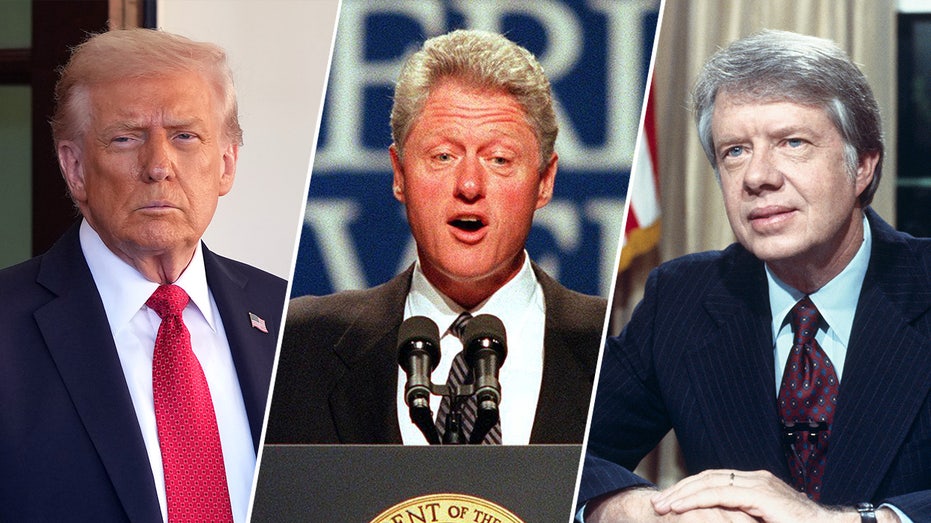There appears to be no end in sight to the current government shutdown, with Democrats and Republicans still far from striking a federal spending deal nearly a month into fiscal year (FY) 2026.
Hundreds of thousands of federal workers have been furloughed and thousands have been laid off. Certain federal services have also paused due to lack of funding.
It is not the first time such a standoff has paused all or some government operations. Below is a list of the top five longest government shutdowns in U.S. history, and how they were resolved.
BATTLEGROUND REPUBLICANS HOLD THE LINE AS JOHNSON PRESSURES DEMS ON SHUTDOWN
The longest government shutdown in history happened during the first Trump administration and lasted five weeks.
Funding for President Donald Trump’s border wall was at the heart of that dispute. Trump had refused to sign a federal spending deal that did not include money for the project, and a standalone bill with $5.7 billion was blocked by a Senate Democrat-led filibuster.
Trump eventually backed a short-term federal funding measure to reopen the government on Jan. 25, 2019, and a few weeks later, Congress approved $1.375 billion for 55 miles of border fencing between the U.S. and Mexico.
It was a partial shutdown, meaning lawmakers managed to strike a deal on five of 12 appropriations bills before their clock ran out.
The current government shutdown is now the second-longest in history, and the longest-ever full shutdown.
That means Congress was unable to strike a federal funding deal on any appropriations bills before the end of FY 2025 on Sept. 30.
Republicans, who control the House and Senate, had offered a seven-week extension of FY 2025 spending levels to give lawmakers more time to hash out next fiscal year’s numbers.
It passed the House on Sept. 19, with support from one Democrat, but has stalled in the Senate 12 separate times.
SCREAMING MATCH ERUPTS BETWEEN HAKEEM JEFFRIES, MIKE LAWLER AS GOVERNMENT SHUTDOWN CHAOS CONTINUES
Democrats are demanding that any federal funding plan also include an extension of COVID-19 pandemic-era enhanced Obamacare subsidies, which are set to expire at the end of this year without congressional action.
As of the most recent tally, at least five more Senate Democrats are needed to overcome a filibuster and pass the measure in the Senate.
Republican leaders have shown no signs of giving in, however, accusing Democrats of trying to jam an unrelated issue into the yearly funding process.
The second of two government shutdowns under former President Bill Clinton lasted three weeks, breaking a record at the time for the longest shutdown in U.S. history.
Republicans had taken control of both the House and Senate in the 1994 midterm elections, leading Clinton on a collision course with then-House Speaker Newt Gingrich, R-Ga.
Gingrich pursued significant cuts to the federal budget after being emboldened by the 1994 red wave in the House following his “Contract with America.”
Clinton, who also pushed for a balanced budget, disagreed with the spending cuts sought by Republicans in Congress.
That was also a partial shutdown, with the departments of energy, defense and agriculture among those funded before the impasse began.
Republicans moved to end that shutdown amid mounting negative public polling for the GOP, NPR reported.
The longest shutdown of former President Jimmy Carter’s four-year term in the White House lasted 18 days, at a time when Democrats controlled all levers of power in Washington.
Carter had vetoed Congress’ bills on defense spending and public works that he thought wasted federal dollars, according to the Washington Post. That included funding for a nuclear-powered aircraft carrier that Carter opposed.
There was also a dispute over abortion in the funding bill for the now-defunct Department of Health, Education, and Welfare.
Congress wound up stripping the funding that Carter opposed from the defense and public works bills, while a compromise was reached on the latter issue.
Much like the current standoff, the 2013 government shutdown also centered on Obamacare — also known as the Affordable Care Act (ACA).
It is the second-longest full shutdown in history behind today’s. At the time, Republicans controlled the House while Democrats held the Senate.
The GOP had insisted on spending bills that rolled back significant portions of Obamacare, then only about three years old.
Senate Democrats rejected such measures passed by the Republican-controlled House, however.
Congress eventually agreed to a short-term spending patch to end the shutdown, and Republicans relented on pushing funding bills with Obamacare cuts.


